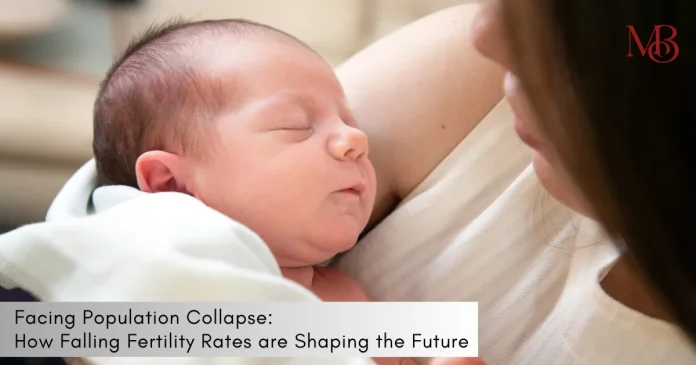Imagine a world where bustling cities turn quieter, schools shut down due to fewer kids, and economies struggle to balance the needs of an aging population with fewer working hands. It may sound like science fiction, but this is a reality many countries could face by the end of the century.
The issue? Falling fertility rates. According to a report by McKinsey Global Institute, major global economies are heading toward a “population collapse.” This isn’t just about fewer babies being born; it’s about the profound ripple effects on societies, governments, and economies. Let’s look into what this means and what can be done.
What’s Happening? The Numbers Tell the Story
To maintain a stable population, countries need a fertility rate of about 2.1 children per family. But today, two-thirds of the world’s population live in countries where fertility is below this replacement rate.
Here’s a quick snapshot of what the future might look like:
| Country | Projected Population Collapse by 2100 |
| China | 55% |
| Italy | 41% |
| Brazil | 23% |
| United States | +23% (thanks to immigration) |
Globally, the ratio of working-age people to retirees has been shrinking. In 1997, there were 9.4 working-age individuals supporting one older person. By 2050, this number is expected to drop to just 3.9.
Population Collapse: Why is This Happening?
While many assume longer lifespans are to blame, McKinsey’s report highlights a different cause: a youth deficit. Simply put, fewer young people are being born.
Key Reasons for Declining Fertility Rates:
- Lifestyle Choices: Many prioritize careers, personal growth, or other goals over starting a family.
- Economic Pressures: The rising cost of living, housing, and education deters many from having children.
- Changing Social Norms: Delayed marriages and shifting gender roles play a role.
- Access to Contraceptives: Increased availability and education about contraception reduce unplanned pregnancies.

Why Should You Care?
Population collapse isn’t just a statistic. It’s a societal challenge that touches many areas of life. Here’s how:
1. Economic Slowdown: Fewer young people mean fewer workers. This leads to slower economic growth and increased financial pressure on the working population to support retirees.
2. Rising Healthcare Costs: With aging populations, healthcare systems face immense strain. More seniors mean more demand for medical care, retirement homes, and social services.
3. Social Security Woes: As the working-to-retired ratio shrinks, funding programs like pensions and Social Security becomes challenging. Governments may need to increase taxes or cut benefits.
4. Geopolitical Shifts: Countries with declining populations may see reduced influence on the global stage. On the flip side, nations with stable or growing populations (e.g., through immigration) could gain an edge.
What Can Be Done?
Addressing population collapse requires bold steps. While reversing fertility trends is difficult, there are other ways to adapt.
1. Encourage Higher Birth Rates: Some countries, like Japan and South Korea, offer financial incentives for families to have more children. These include:
- Paid parental leave
- Free childcare
- Tax breaks for larger families
While helpful, these measures haven’t drastically boosted fertility rates yet.
2. Embrace Immigration: Immigration can offset population collapse. The U.S., for instance, is projected to grow by 23% due to immigration. Welcoming skilled workers and creating inclusive policies can help balance demographics.
3. Redefine Work and Retirement: With fewer young workers, older people might need to stay in the workforce longer. Businesses can:
- Offer flexible hours for seniors
- Create roles suited for older employees
- Leverage mentorship opportunities
4. Boost Productivity with Technology: Artificial intelligence (AI) and automation can help address labor shortages. By improving productivity, these technologies can reduce the reliance on a large workforce.
5. Change Social Norms: Promoting work-life balance and reducing the stigma around family-friendly policies can encourage more people to have children. Countries might need to rethink long work hours and provide better support for working parents.
Parenting Competency in Denmark: The Outcry, Public Reactions, and Official Deflections
What About the Environment?
Some argue that population collapse could benefit the environment, reducing resource consumption and carbon emissions. However, McKinsey’s report suggests that sustained economic growth is crucial for funding global efforts like the net-zero transition.
The Role of Businesses
Companies will need to adapt to demographic changes:
- Target Older Consumers: Businesses must cater to the growing senior market with tailored products and services.
- Upskill Workers: Investing in training programs can help older employees stay productive.
- Promote Inclusion: Creating diverse workplaces that value all age groups will be key.
Is Hollywood Sign on Fire? Here’s the Truth You Need to Know
A Silver Lining?
Despite the challenges, McKinsey remains optimistic. Humanity has faced and adapted to crises before. We can navigate this demographic shift with innovation, collaboration, and proactive measures.
FAQs
1. Why is a fertility rate of 2.1 important?
A rate of 2.1 ensures population stability, balancing births and deaths. It’s the minimum needed to maintain a country’s population without immigration.
2. Which countries are most affected by falling fertility rates?
China, Italy, and Brazil face significant declines. However, nations like the U.S. may offset these effects through immigration.
3. Can governments increase fertility rates?
While policies like financial incentives and parental leave can help, no country has successfully reversed fertility declines significantly.
4. How does population decline affect younger generations?
Younger people may face higher taxes, slower economic growth, and greater responsibility for supporting aging populations.
The future may seem uncertain, but with informed decisions and global cooperation, humanity can turn challenges into opportunities. By planning ahead, we can create societies that thrive despite demographic shifts. Follow our Newscast page for more such articles.


